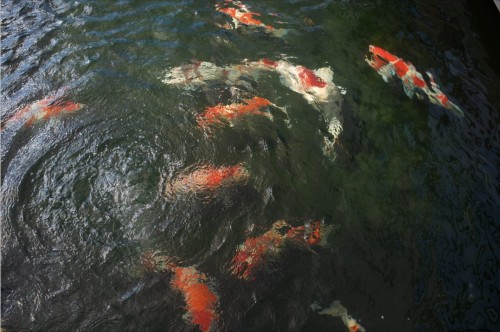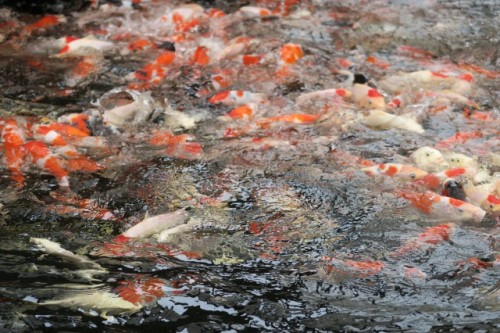1




















| Thumbs Up |
| Received: 35,722 Given: 17,037 |

The Japan’s Agricultural Heritage : Yamakoshi – The Birthplace of Nishiki Koi
Source: http://voyapon.com/japans-agricultur...amakoshi-carp/
Carp, or koi fish – they’re a ubiquitous facet of water gardens worldwide. While staring down the colorful fish in the water features of upscale houses or Asian buffets of dubious authenticity, one rarely stops to consider the history behind koi – they are simply there to lend to the “Eastern” aesthetic. However, to Japanese, and particularly those familiar with Yamakoshi Village’s famed Nishiki-koi, they are far more than merely ornamental. They represent a source of local pride and a longstanding cultural heritage that has been diligently maintained for over a century.
Koi cultivation in Yamakoshi and elsewhere in Japan dates back over 400 years; however, they were not always the vividly-colored, aesthetic creatures we now know them as today. Originally, koi were bred for food and were typically only found in black or brown. In the late 19th century, the farmers of Yamakoshi noticed the emergence of red and orange carp among the otherwise monochromatic consumption-cultivated koi, prompting them to begin breeding them for aesthetic purposes. The result was the colorful creatures we now know as ornamental koi, referred to Nishiki-koi or nishikigoi in Japanese (literally translating to “colored fish”).
In 1889, the first variety of Nishiki-koi, “Kohaku” was designated. There have since been over 100 subsequent varieties bred, each with their own unique palette and patterns. Referred to as “swimming jewels”, these dynamically-colored new types of Koi were first made known outside of Japan when they were exhibited at an annual exhibition in Tokyo in 1914. They have since become a coveted commodity worldwide, and though there are plenty of koi farms, there are none so adamantly maintained as those in their birthplace of Yamakoshi. It is important to note that koi cultivation in Japan is often seen just as much as a hobby, as it is an industry. While the larger-scale farms are one aspect of Yamakoshi’s koi industry, some of the locals will cooperate with them, owning small hobby ponds on the side, in addition to having a “day job” in the nearby city of Nagaoka. Beyond commodity, Yamakoshi’s Nishiki-koi are considered living culture, and are treated with the care and passion deserving of such.
Nishiki-koi can now grow to be roughly a meter in size, and no expense is spared in raising them to be as hearty as it is possible. Fish are culled throughout a highly selective breeding process, to ensure the proper variations in shape and color are maintained. The village of Yamakoshi, in particular, is one of the most luxurious homes that these fish could hope to have. In the winter, they are kept in climate controlled fish farms, and throughout the rest of the year they occupy the field-side outdoor ponds, spanning the village’s mountain-shrouded paddies.
The fish are released into the mirrored ponds from May until Fall, eventually being either sold, or moved back into the indoor ponds between September-November. Yamakoshi’s Nishiki-koi are exported to over 50 countries across the world. The village boasts types of koi seen nowhere else, cultivating one-of-a-kind breeds which attract enthusiasts and collectors. These “designer fish” may be auctioned off to bidders across Japan, and the world, fetching audaciously high prices (although this constitutes less than 0.01% of the fish produced in Yamakoshi – the majority of which are the more modest variety).
On October 23rd, 2004, the industry and cultural heritage of Nishikigoi was jeopardized when a series of severe earthquakes struck Niigata prefecture. Roads into Yamakoshi village were destroyed, requiring residents to be evacuated from the village by helicopter. Stranding the fish amidst the ruins, Yamakoshi’s culture, and economy were deeply threatened by the earthquakes, as well as the subsequent landslides and erosion.
Cherishing the precious fish, breeders would return on November 18th, airlifting the Nishiki-koi out in a rescue operation that would rescue 450 koi on that day alone, and an eventual total of 2200. Today, after much painstaking effort, the koi ponds have been reconstructed, and the mirrored ponds are now beautiful as ever. Although the fish tend to be somewhat camera shy, with a keen eye they can easily be spotted – and that failing, the koi farmers will likely be kind enough to beckon them for you with food.
Nishiki-koi are a sight to behold. Their elegant, powerful forms shimmering beneath the surfaces of the mirrored ponds. There is something surreal about seeing the origin place of a living creature once thought to be commonplace, and indeed, ornamental. Those who visit Yamakoshi may be surprised to find that they can no longer look at these fish without at least a glint of admiration – to take these fish for simply their novelty is to neglect their heritage of resilience and innovation. Beyond decor, Nishiki-koi are living works of art.



















| Thumbs Up |
| Received: 35,722 Given: 17,037 |

Visiting A ‘Nishiki Koi’ Farm – the Elegance and Power of the Colourful Carp
Source: http://voyapon.com/nishiki-koi-yamakoshi-niigata/
The Birthplace of Nishiki Koi (Coloured Carp)
The elegance and power of the colourful carp, Nishiki Koi (Coloured Carp), is known far and wide around the world, yet very few people know of their origin, birthplace and laboured past. The Nishiki Koi have endured more than most but have emerged once again, bringing with them the perfect blend of explosive colours, stunning beauty, strength and resilience.
Rebuilding After Disaster
In 2004, a devastating earthquake hit Yamakoshi, the birthplace and origin of the Nishiki Koi, flooding their ponds, collapsing their cattle sheds and demolishing their homes. The people desperately rushed to save their precious Nishiki Koi, using helicopters to fly them to temporary ponds, in a desperate hope to save even just a few. Unfortunately, many were lost to the earthquake and the people, out of desperation, even began to eat those that didn’t make it. The industry took an immeasurable blow. Farming facilities were crushed, houses lost and the industry set on the brink of extinction. However, all was not lost. And, as the village began to rebuild itself, so did the industry, using the few Nishiki Koi as the starting place. Teams of young people were soon formed, each bringing new ideas into the industry, as their hopes were not simply to rebuild and regain what was lost, but to make the industry different and better.
It was a good few years before the Nishiki Koi could return to the ponds that they once fled, but when they did, it was received with a great deal of happiness and celebration, as it was a true sign to the villagers that they were making big steps in regaining what they had once lost. And, in a true display of absolute resilience and strength, not only did the industry manage to get back to its former glory, it also actually improved and is now more vibrant and successful than it has ever been.
Visiting Marushiage Carp Farm
Upon visiting the farm, I found out exactly how popular and thriving the industry really is. Even though the farm I visited seemed surprisingly simple from the outside, I soon found out that this family of a father and his three sons, had grown their family business into something almost immeasurable to me. The family at Marushiage carp farm, whose business actually began with their grandfather, actually own around sixty ponds, scattered all around the village, with some being a good 10 minutes drive from the actual farm building itself. The ponds varied in size slightly, each containing a variety of more fully grown Nishikigoi and completed with an automated food dispenser, set to release food four times a day. It is here where the fish will grow and develop until it is time for them to be sold either at auction or through websites and visits.
An International Industry
As the industry has developed, so too has their international market, particularly in Europe and also in America who have grown fond of the beautiful colours, patterns and elegance of the Nishiki Koi. In October, a great number will actually make the effort to visit the farms and the ponds in person, to be sure of obtaining the perfect Nishiki Koi in the various auctions that begin to take place. The season trails off in the Spring however, as attention and focus is switched to the precise and selective process of breeding the Nishiki Koi, to create the perfect shape, size and colours for the next season.
Varieties and Differences in Nishiki Koi
Although bred from the simple carp, the Nishiki Koi now come in a variety of different shapes, sizes, lengths and builds, each carrying their own individual patterning, vibrant colours and the specific name for their classified variety. The most popular variety among the Japanese people are the Tancho Nishiki Koi, which is the most traditional and one of the most simplistic of all the varieties, featuring just a single large, bright red spot on the top of it’s white head. Nishiki Koi can also feature warm oranges, dramatic reds, shimmering golds, whites and blacks in varying patterns and styles due to the precisely selected breeding process. There is also a great focus on breeding to create female fish, as these tend to have fuller, more muscular and more desirable figures than the male Nishikigoi.
Carp Ponds Scattered Among the Rice fields
When I first arrived at the farm, I was surprised by its simplicity. There were only two sheds that I could see and the first contained no Nishiki Koi. The second looked just like a greenhouse and contained two lively pools of young, small but still completely stunning fish that were only three weeks old. The tiny pool must have contained around thirty fish, following each other and flopping over each other to create some occasional stunning and surprising brief flying fish displays. They were full of energy, vibrancy and colour, all varieties living and developing together until the time comes to move to the big ponds.
There are around 10 – 15 farmers in the area of Yamakoshi alone, varying from the serious full-timers to those who use it as a delightful hobby. As a result, ponds scatter the landscape, featuring almost as frequently as the golden rice fields in and amongst the tiers of the landscape. And, if the beautiful carving patterns of the vibrant and elegant Nishikigoi aren’t enough to bring you to Yamakoshi, the stunning views of the distant mirrored ponds just might be.
The farms are not usually available for tours or viewings, yet I was lucky enough to be given a tour of the main farm and driven to some of the outlining ponds in the area. However, if you visit Yamakoshi, you are sure to see the colourful, watery imprint of the Nishiki Koi’s trail through a serine, blue canvas.

There are currently 1 users browsing this thread. (0 members and 1 guests)
 Christianity
Christianity
 Eesti
Eesti
Bookmarks